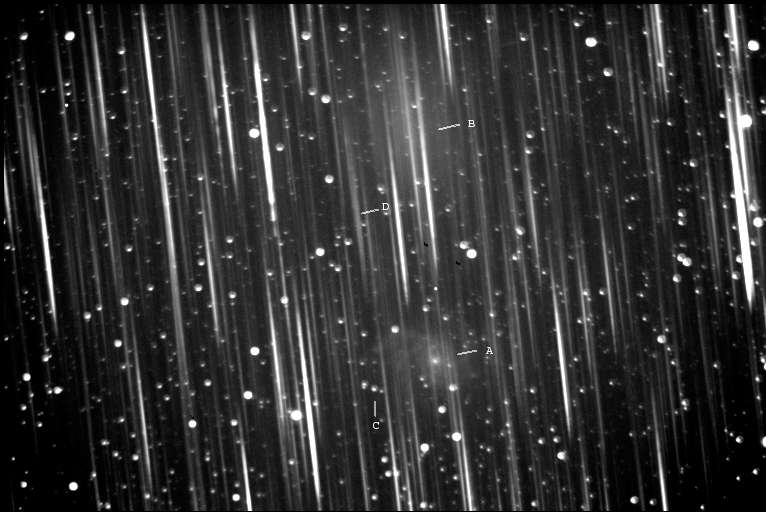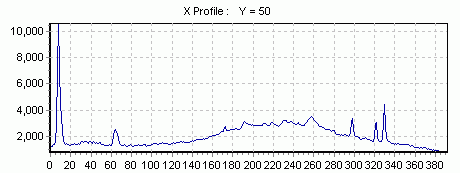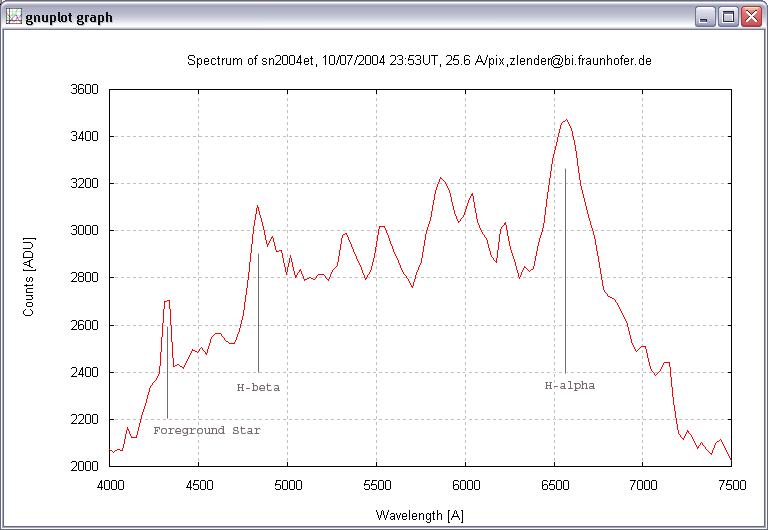
I did not expect to present the spectrum of a second supernova so soon.
My first successful attempts to obtain a supernova spectrum were made late in August of this year. Unusual bad weather prevented me to take more spectra of supernova SN2004dj for more than a month now. Meanwhile, by chance another extraordinary bright SN (mag 13) apeared early in October in NGC6946, a Sb-Type galaxy in northern Cygnus. This time the sn rides high in the sky, much better to image from my site.
NGC6946 is the most prolific galaxy known. No other galaxy showed as many supernovae as this one in the course of a century. Astronomers expect to find one to three supernovae per century in a typical galaxy like our own. The complete list counts 8 events, namely 1917A, 1939C, 1948B, 1968D, 1969P, 1980K , 2002hh, 2004et. Among them only SN1980K (mag 11.4) was brighter than SN2004et. Again weather demanded to be patient.

Image and first oder spectra of NGC6946 and SN2004et at indicated positions. Date 2004/10/07 23:53UT. 7 images of 4 min integration time were added. Camera SBig ST-8E, binning 2x2, telescope Newton 8inch f/4.6, Rainbow Optics grating. This type of spectroscope has strong field curvature, therefore one does not focus on stars but on spectral lines.
In a slitless grid spectrograph stars appear beside their first order spectra. The galaxy shines also through. It is obvious, that an object like this one is not an easy target for spectroscopy. So many field stars make it hard to obtain an undisturbed spectrum. Some experimentation was required to achieve the goal. Position A marks the center of NGC6946, B indicates its diffuse spectrum . The tiny star above C is the supernova and D marks its spectrum, which is closely sited to the spectra of two other stars of comparable brightness, south of C.
Spectroscopic techniques, calibration from pixels to Angstrom, ... are described in my introduction to spectroscopy

Detail from the first image above, rotated 96.2 deg CCW and stretched in Y. The red cross marks line y=50. This profile is seen in the following diagram. Most of the prominent peaks are foreground stars, which all belong to our own galaxy. The one at x=10 is SN2004et.

Graph above shows the horizontal profile at position y=50 in above image detail. Most of the prominent peaks are resulting from faint foreground stars.
![]()

Spectrum of SN2004et, 10/07/2004j. The peak at 4330 Angstrom is not a spectral feature. It results from the image of a foreground star.
What can we say about the supernova from this spectrum?
Most prominent features seen are the rather strong emission lines of H-alpha
at 6563 Angstrom and H-beta at 4861 Angstrom. The presence of hydrogen, classifies
the supernova as Type II, because Type I sn have no hydrogen at all in their
spectra. The P-Cygni profile at H-alpha is not as prominent as it was in SN2004dj,
but it shows up at H-beta. The differences in wavelength between minima and maxima allows
us to estimate the velocities which are related to such an explosive
event. From blueshift in H-alpha we obtain v= (10500  800) km/s and H-beta gives v= (9750
800) km/s and H-beta gives v= (9750  500) km/s in approach for the shells, where v = c
500) km/s in approach for the shells, where v = c  and c is the vacuum speed of light. Compared to SN2004dj this seems to be a more
energetic blast. In comparison with Type I sn, Type II supernovae form a much
more heterogeneous class with respect to their energy release with wide dispersion.
Maximum absolute luminosities range from Mv= -15.5 (SN1987A) to Mv= -18.
and c is the vacuum speed of light. Compared to SN2004dj this seems to be a more
energetic blast. In comparison with Type I sn, Type II supernovae form a much
more heterogeneous class with respect to their energy release with wide dispersion.
Maximum absolute luminosities range from Mv= -15.5 (SN1987A) to Mv= -18.
Comments welcome, contact:
![]()